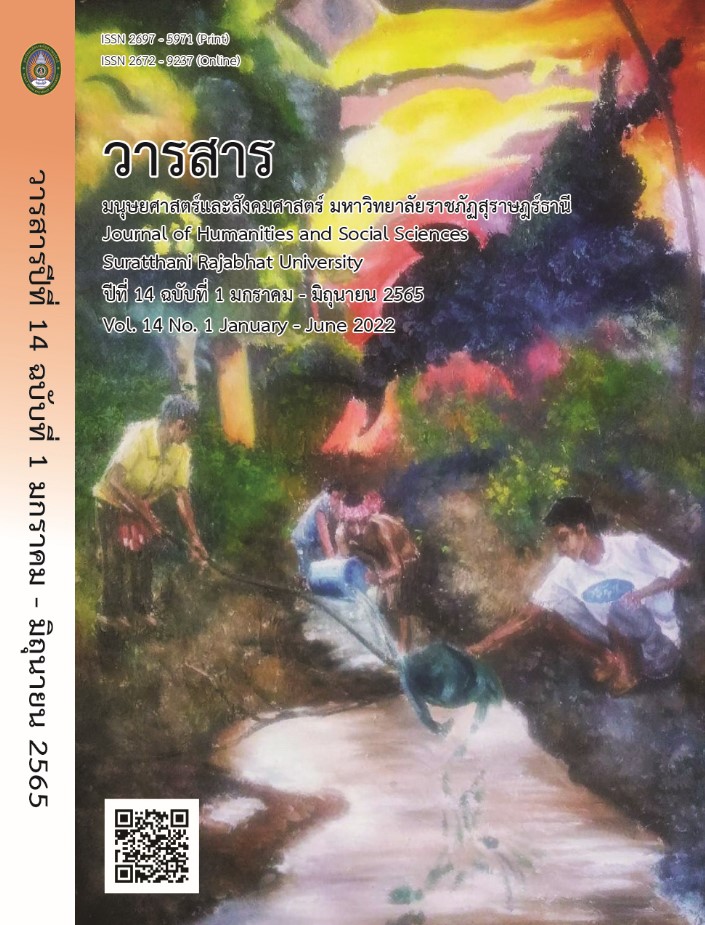Music Composition “Reflection of Tapee” for Chamber Ensemble
Main Article Content
Abstract
Music composition “Reflection of Tapee” for chamber ensemble is a music composition for Nora Pi, clarinet, and percussion. The composition is intended to create a new piece that integrates the concept of Western and folk musical culture with Western contemporary music composition techniques. In addition, this piece conveys impressive beauty attractiveness and realizes preserved local value. This Music Composition consists of three movements: the first movement, “Soul” for Solo Nora Pi, portrays the identity of the performance technique of Nora Pi; the second movement, “Spirit” for solo Eb Clarinet, presents an imitation of Thailand’s southern folk music style and tone color; the third movement “The Mirror of Soul and Spirit,” Trio for Nora Pi, Bb Clarinet, and Percussion expresses both culture cross between East and West. The total duration of the “Reflection of Tapee” for the chamber ensemble is approximately 15 minutes, 3 - 5 minutes per movement. Each movement is composed of its character in a unique musical form. Therefore, the composition can be called experimental music, further developing a contemporary music composition approach that delivers both aesthetic and academic value.
Article Details

This work is licensed under a Creative Commons Attribution-NonCommercial-NoDerivatives 4.0 International License.
All published manuscripts have been verified by peer-peer professors in the fields of humanities and social sciences. Reprinting of the article must be authorized by the editorial staff.
References
แขไข ธนสารโสภิณ และ วิบูลย์ ตระกูลฮุ้น. (2560). วิเคราะห์บทประพันธ์เพลง
ปรากฏการณ์ ของณรงค์ ปรางค์เจริญ. วารสารดนตรีรังสิต. 12(2), 17-29.
ชวน เพชรแก้ว และ สบาย ไสยรินทร์. (2544). สุราษฎร์ธานีของเรา. กรุงเทพฯ: กรุงสยามการ
พิมพ์.
ณรงค์ชัย ปิฎกรัชต์. (2544). มานุษยดนตรีวิทยาดนตรีพื้นบ้านภาคใต้. นครปฐม:
วิทยาลัยดุริยางคศิลป์ มหาวิทยาลัยมหิดล.
ณรงค์ฤทธิ์ ธรรมบุตร. (2553). อรรถาธิบายและบทวิเคราะห์บทเพลงที่ประพันธ์โดย
ณรงค์ฤทธิ์ ธรรมบุตร. กรุงเทพฯ: ธนาเพรส.
ณัชชา พันธุ์เจริญ และคณะ. (2559). ดนตรีลิขิต: รวมบทความดนตรีสร้างสรรค์เชิง
วิชาการ. กรุงเทพฯ: ธนาเพรส.
ทัพพสาร เพ็งสงค์ และ พรประพิตร์ เผ่าสวัสดิ์. (2559). กลวิธีการเดี่ยวปี่คลาริเน็ตบีแฟล็ต
เพลงเชิดนอกของพันโทวิชิต โห้ไทย. วารสารศิลปกรรมศาสตร์ จุฬาลงกรณ์
มหาวิทยาลัย. 2(2), 122 - 127.
ยศ วณีสอน. (2559). จากปี่ในสู่ปี่นอก. วารสารเวอริเดียน ฉบับภาษาไทย สาขา
มนุษยศาสตร์ สังคมศาสตร์และศิลปะ. 9(2), 1769 – 1786.
วิบูลย์ ตระกูลฮุ้น. (2559). แถวโน้ตสิบสองเสียงในดนตรีเอโทนัล. วารสารดนตรีรังสิต.
(2), 13 - 36.
สังคีต กำจัด. (2556). ปี่ไทยกับการตีความผ่านงานประพันธ์เพลงร่วมสมัย. วิทยานิพนธ์
ดศ.ม. (สังคีตวิจัยและพัฒนา). นครปฐม: มหาวิทยาลัยศิลปากร.
Ariana Warren. (2014). 21st Century Beginning Clarinet Method. D.M.A. disd.
University of California San Diego.
Chinary Ung. (2003). Mohori for Mezzo-Soprano and Chamber Ensemble.
Dissertation, D.M.A. (Clarinet and Conducting). Cincinnati: Columbia
University.
Evan Norcross Flynn. (2014). Liberation of the Senses: An Exploration of
Sound –Color Synesthesia in the Music of Alexander Scriabin and
Olivier Messiaen. Dissertation, M.A. (Music). Lawrence: University of
Kansas.
Lee, Sungpil. (2019). East meets West: Reconciling Performance Tradition in
the Clarinet Works of Isang Yun. Dissertation, Ph.D. (Music).
Melbourne: University of Melbourne.


